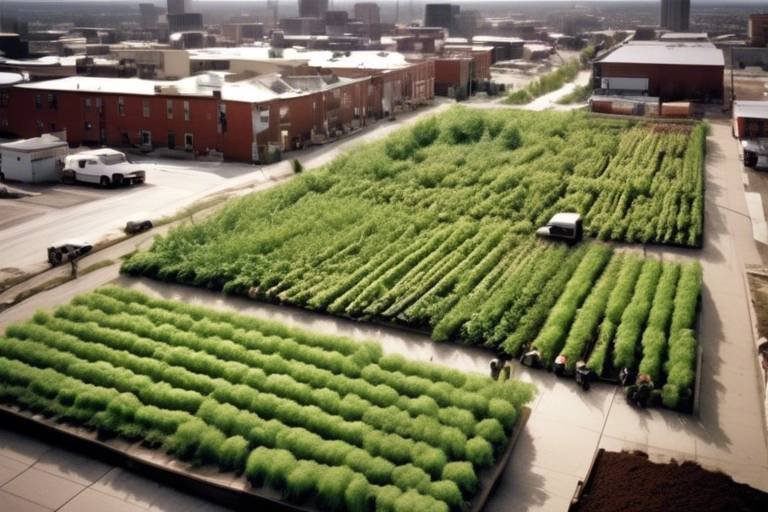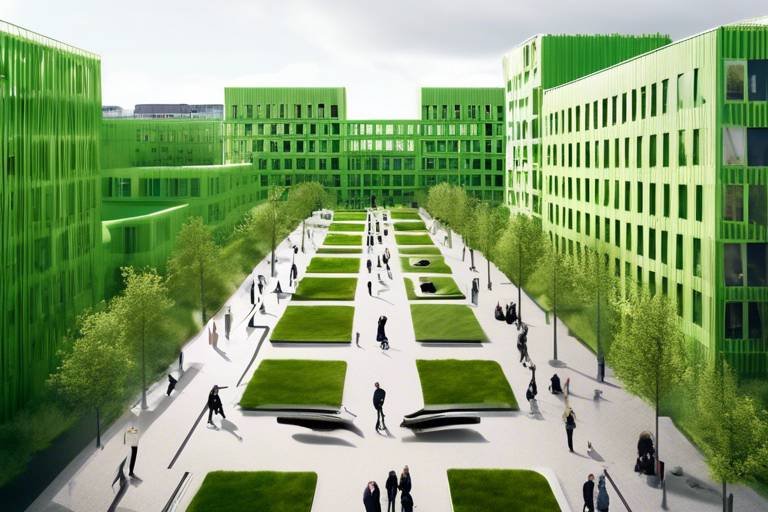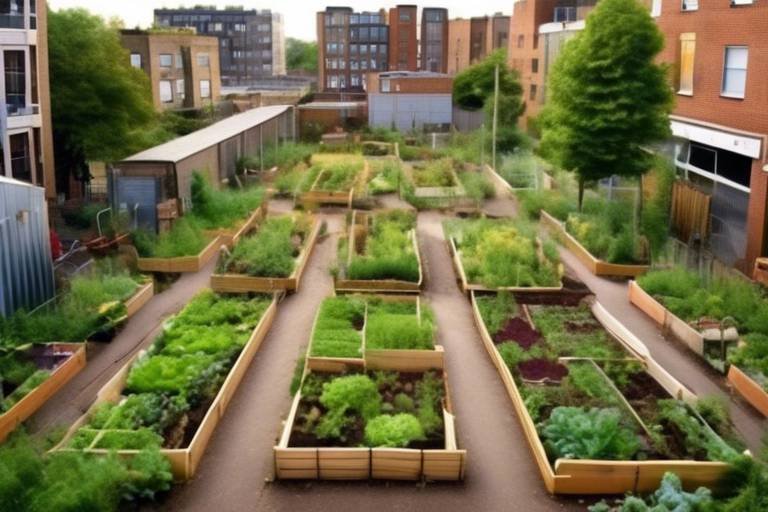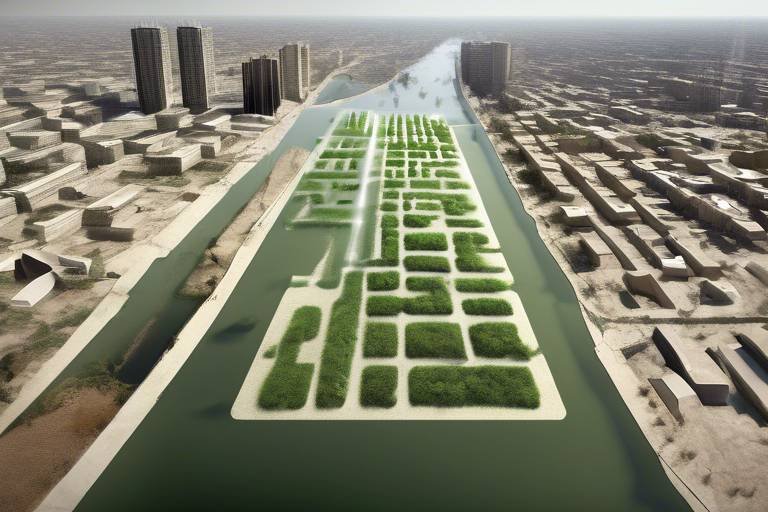Inner City Agriculture: Boosting the Local Economy and Urban Sustainability
In the heart of bustling cities, where concrete jungles dominate the skyline, a remarkable transformation is taking place. Inner city agriculture is emerging as a beacon of hope, breathing life into urban spaces and paving the way for a sustainable future. Imagine walking through your neighborhood and spotting vibrant community gardens, rooftop farms, and urban greenhouses. These initiatives are not just about growing food; they are about cultivating community, enhancing local economies, and promoting a greener planet.
As we delve into the world of inner city agriculture, we uncover a multitude of benefits that extend far beyond the produce harvested. It's about food security, where fresh, healthy options are accessible to all. It's about mental health, where green spaces provide a sanctuary from the chaos of urban life. And it's about community engagement, where neighbors come together to cultivate not just crops, but relationships and a sense of belonging.
This article will explore how inner city agriculture acts as a catalyst for economic growth and sustainability in urban environments. From creating job opportunities to enhancing property values, the impact is profound. But it's not all sunshine and rainbows; challenges such as limited space and regulatory hurdles threaten these initiatives. Yet, through innovation and community effort, urban farming can thrive, turning challenges into opportunities.
Inner city agriculture offers numerous advantages, including increased food security, improved mental health, and community engagement. It transforms urban spaces into productive areas that benefit residents and local economies.
Inner city agriculture is not just about growing food; it’s about stimulating local economies. By creating jobs, supporting small businesses, and enhancing property values, urban farming initiatives contribute to a more vibrant community. Let’s break down some of these economic impacts:
One of the most significant benefits of inner city agriculture is its ability to generate employment opportunities. From farming to distribution, a variety of jobs are created, providing urban residents with a pathway to sustainable income. Consider the following types of jobs that emerge from these initiatives:
- Farmers and Gardeners: Responsible for planting, cultivating, and harvesting crops.
- Educators: Offering workshops and training sessions on sustainable practices.
- Logistics and Distribution: Ensuring that fresh produce reaches local markets and restaurants.
- Sales and Marketing: Promoting local produce to enhance visibility and sales.
Each of these roles not only contributes to the economy but also fosters a sense of community, as individuals work together towards a common goal.
Many urban farms recognize the importance of empowering community members through education. Skills development programs are often at the forefront of these initiatives, equipping individuals with valuable knowledge and practical skills. These programs can range from:
- Workshops on Organic Farming: Teaching sustainable practices and techniques.
- Business Training: Helping aspiring entrepreneurs learn how to run successful local businesses.
- Health and Nutrition Education: Promoting the benefits of consuming fresh, local produce.
By fostering workforce development, these programs not only enhance individual livelihoods but also contribute to the overall health of the community.
Inner city agriculture thrives on the principle of local sourcing. By sourcing produce locally, urban farms create a symbiotic relationship with nearby businesses, driving economic growth. For instance, local restaurants can partner with urban farms to offer fresh, seasonal dishes, while farmers benefit from guaranteed sales. This collaboration leads to:
- Increased Foot Traffic: More customers visiting local shops.
- Stronger Community Ties: Businesses working together to support one another.
- Enhanced Property Values: Vibrant neighborhoods attract more residents and investors.
As these partnerships flourish, they contribute to a more dynamic and resilient local economy.
Inner city agriculture is a powerful tool for promoting sustainable urban development. By integrating green practices into the urban landscape, these initiatives help reduce carbon footprints and enhance biodiversity. Urban farms contribute to:
- Improved Air Quality: Plants filter pollutants and produce oxygen.
- Stormwater Management: Green spaces absorb rainwater, reducing runoff.
- Urban Heat Mitigation: Vegetation cools the environment, combating the urban heat island effect.
Ultimately, inner city agriculture plays a crucial role in creating a more sustainable urban ecosystem, benefitting both the environment and the community.
Despite its numerous benefits, inner city agriculture faces challenges that can hinder its growth. Factors such as limited space, zoning regulations, and access to resources can create significant obstacles. Understanding these challenges is essential for fostering successful urban farming initiatives.
Limited access to suitable land is one of the most pressing challenges for urban farmers. Innovative approaches, such as vertical farming and rooftop gardens, can help maximize urban space and resources. By utilizing technology and creative designs, urban farmers can overcome these barriers and continue to thrive.
Zoning laws and regulations can pose significant challenges for inner city agriculture. Advocacy and policy changes play a crucial role in supporting urban farming initiatives. By working with local governments to promote favorable policies, urban farmers can create a more conducive environment for growth and sustainability.
Q: What is inner city agriculture?
A: Inner city agriculture refers to the practice of growing food in urban environments, utilizing available spaces such as rooftops, vacant lots, and community gardens.
Q: How does inner city agriculture benefit the local economy?
A: It creates jobs, supports local businesses, increases property values, and enhances community engagement, leading to a more vibrant urban area.
Q: What are some challenges faced by urban farmers?
A: Challenges include limited access to land, zoning regulations, and resource availability, but innovative solutions can help overcome these obstacles.
Q: How can I get involved in inner city agriculture?
A: You can participate by volunteering at local urban farms, starting your own garden, or supporting local farmers' markets.

The Benefits of Inner City Agriculture
Inner city agriculture is not just a trend; it's a transformative movement that brings a plethora of benefits to urban environments. Imagine a bustling city where vacant lots and rooftops are not just spaces filled with debris but thriving gardens and farms. This shift not only beautifies the landscape but also significantly enhances food security for local residents. By growing food right where it’s consumed, communities can reduce dependency on external food sources, which often come with long transportation times and carbon footprints. With fresh produce within arm's reach, families can enjoy healthier diets and improved nutrition.
But the advantages of inner city agriculture extend beyond just food. It also plays a crucial role in enhancing mental health and fostering community engagement. Studies show that spending time in green spaces can reduce stress and anxiety levels. Urban farms provide a unique opportunity for residents to connect with nature, cultivate plants, and engage in meaningful activities. The act of growing food can be therapeutic, offering a sense of accomplishment and purpose. Moreover, these spaces often serve as community hubs where people can come together, share experiences, and build relationships, creating a stronger sense of community.
Furthermore, inner city agriculture can lead to increased economic opportunities. By transforming underutilized urban spaces into productive areas, cities can create new jobs and stimulate local economies. For instance, farmers’ markets and community-supported agriculture (CSA) programs not only provide fresh produce but also support local artisans and small businesses. When residents buy from these local sources, they are investing in their community, which can lead to a vibrant local economy. This interdependence fosters a cycle of growth and sustainability that benefits everyone involved.
In summary, the benefits of inner city agriculture are multifaceted. From improving food security and mental health to boosting local economies and community engagement, urban farming is a powerful tool for creating sustainable and resilient cities. It’s a win-win situation that not only enhances the quality of life for residents but also contributes to the overall health of the urban ecosystem.
- What is inner city agriculture? Inner city agriculture refers to the practice of cultivating, processing, and distributing food within urban areas, utilizing available spaces like rooftops, vacant lots, and community gardens.
- How does inner city agriculture improve food security? By growing food locally, communities can reduce reliance on external food sources, ensuring access to fresh produce and improving nutrition.
- Can urban farming help with mental health? Yes, engaging in gardening and spending time in green spaces has been shown to reduce stress and improve overall mental well-being.
- What economic benefits does inner city agriculture provide? It creates jobs, supports local businesses, and enhances property values, contributing to a more vibrant urban economy.

Economic Impact on Local Communities
Inner city agriculture is not just about growing food; it’s a powerful engine driving economic growth and revitalizing local communities. By transforming vacant lots and underutilized spaces into productive urban farms, cities can experience a renaissance that touches every corner of the economy. Imagine walking through your neighborhood and seeing vibrant gardens where once there were only abandoned buildings. This transformation not only beautifies the area but also creates a ripple effect that enhances the local economy.
One of the most significant impacts of inner city agriculture is job creation. Urban farms require a diverse range of roles, from farmers to marketers, and even chefs who can turn fresh produce into delicious meals. These jobs are crucial, especially in areas where employment opportunities may be scarce. According to recent studies, every new urban farm can create multiple full-time positions, which is a boon for local residents seeking work. Additionally, these jobs often come with the added benefit of connecting individuals to their community, fostering a sense of belonging and purpose.
Furthermore, inner city agriculture supports small businesses by providing them with fresh, locally sourced produce. This creates a symbiotic relationship where urban farms and local businesses thrive together. For instance, a nearby restaurant can source its ingredients from local farms, promoting a farm-to-table movement that not only enhances the dining experience but also supports the local economy. As these businesses grow, they contribute to the community by providing more jobs and generating tax revenue that can be reinvested into public services.
Another aspect to consider is the impact on property values. Areas that embrace inner city agriculture often see a noticeable increase in property values. When neighborhoods are filled with green spaces and thriving farms, they become more attractive to potential homeowners and investors. This increase in property values can lead to a more vibrant urban area, as new residents bring diverse ideas and resources, creating a dynamic community.
To illustrate the economic impact further, let's take a look at a few statistics:
| Metric | Impact |
|---|---|
| Jobs Created | Approximately 10-15 jobs per urban farm |
| Increase in Local Business Revenue | 20-30% increase reported by local restaurants |
| Property Value Increase | 5-10% rise in property values in farm-adjacent areas |
In conclusion, the economic impact of inner city agriculture extends far beyond the simple act of growing food. It creates jobs, supports local businesses, enhances property values, and fosters a sense of community. As cities continue to grapple with economic challenges, embracing urban farming can be a transformative strategy that benefits everyone involved.
- What is inner city agriculture? Inner city agriculture refers to the practice of cultivating, processing, and distributing food within urban areas, often utilizing vacant lots or underused spaces.
- How does inner city agriculture create jobs? Urban farms require a variety of roles, including farming, marketing, and distribution, which generates employment opportunities for local residents.
- Can inner city agriculture really boost property values? Yes, neighborhoods that incorporate urban farms often see an increase in property values due to enhanced aesthetics and community appeal.
- What challenges do urban farmers face? Common challenges include limited access to land, zoning regulations, and securing resources for farming operations.

Job Creation Opportunities
Inner city agriculture is not just about growing food; it’s about cultivating opportunities for residents. The rise of urban farming has sparked a wave of job creation that extends beyond traditional farming roles. From community gardens to rooftop farms, these initiatives are generating diverse employment opportunities that can uplift entire neighborhoods. Have you ever thought about how a small plot of land can turn into a bustling hub of activity? Well, it’s happening all around us!
Let’s break it down. Urban farming creates jobs in various sectors, including:
- Farming and Horticulture: This includes positions for farmers, gardeners, and agricultural technicians who work directly with the crops.
- Distribution and Sales: Roles in logistics, marketing, and sales emerge as local produce needs to be delivered to markets, restaurants, and consumers.
- Education and Outreach: Many urban farms hire educators to teach the community about sustainable practices, nutrition, and gardening skills.
- Research and Development: Innovative farming techniques require research, leading to jobs in agricultural science and technology.
Each of these roles not only provides a paycheck but also empowers individuals with new skills and knowledge. Imagine a young person learning how to grow their own food and then teaching others in their community. That’s the ripple effect of inner city agriculture!
Moreover, the jobs created are often accessible to a diverse population, including those who may face barriers to employment. Urban farms frequently prioritize hiring from within the community, which means they are providing opportunities for local residents who might otherwise struggle to find work. This approach fosters a sense of ownership and pride among community members, as they see their labor directly contributing to local food systems.
It's also worth noting that these jobs can lead to career advancement. For instance, someone starting as a farmhand can gain valuable experience and eventually move into managerial roles or even start their own urban farming venture. The potential for growth is enormous, and it contributes to a more resilient local economy.
In summary, the job creation opportunities stemming from inner city agriculture are multifaceted and impactful. They not only provide employment but also foster community ties, promote sustainability, and enhance the overall quality of life in urban areas. Who knew that a patch of green in the concrete jungle could yield so much more than just vegetables?
- What types of jobs are available in inner city agriculture? There are various roles, including farming, distribution, education, and research.
- How does urban farming benefit the community? It creates jobs, improves food security, and fosters community engagement.
- Can anyone participate in urban farming? Yes! Many urban farms are open to community members and offer training programs.
- What challenges do urban farmers face? Common challenges include limited access to land, zoning regulations, and resource availability.

Skills Development Programs
In the heart of urban jungles, where concrete often overshadows greenery, in inner city agriculture are blossoming like wildflowers. These programs are not just about planting seeds in the ground; they are about planting seeds of knowledge in the minds of community members. By participating in these initiatives, individuals gain hands-on experience and essential skills that can lead to meaningful employment opportunities. Imagine learning how to cultivate a garden and, in the process, cultivating a career!
One of the most exciting aspects of these programs is their ability to cater to a diverse audience. From school children to senior citizens, anyone can benefit from the training offered. These programs often include workshops on various topics, such as:
- Organic farming techniques
- Soil health and management
- Composting and waste reduction
- Business skills for running a farm
- Nutrition education and food preparation
By equipping participants with a broad range of skills, these programs not only enhance individual capabilities but also foster a sense of community. Participants often form bonds as they work together, sharing their experiences and knowledge. This camaraderie can lead to collaborative projects that further enrich the local agricultural landscape.
Moreover, many urban farms partner with local educational institutions to provide accredited courses. This collaboration ensures that the training is recognized and valued, giving participants a tangible credential that can boost their employability. For instance, a recent program in a city’s community garden resulted in over 200 certifications awarded to individuals who completed their training. This not only empowers the participants but also enhances the reputation of urban agriculture as a legitimate career path.
In addition to formal training, mentorship plays a crucial role in these programs. Experienced urban farmers often take on the role of mentors, guiding newcomers through the intricacies of urban farming and business management. This relationship is invaluable, as it provides practical insights and personal encouragement that can make all the difference in a participant's journey. It’s like having a seasoned guide while trekking through a dense forest—without them, one might easily lose their way!
Ultimately, the impact of skills development programs in inner city agriculture extends far beyond the individual. As participants gain knowledge and confidence, they often become advocates for sustainable practices within their communities. This ripple effect can lead to a greater appreciation for local food systems, healthier eating habits, and increased community engagement. In essence, these programs are not just about growing food; they are about growing a vibrant, sustainable community.
Q: What types of skills can I learn in these programs?
A: Participants can learn a variety of skills, including organic farming techniques, soil management, composting, nutrition education, and business management for agricultural enterprises.
Q: Are these programs suitable for beginners?
A: Absolutely! Many programs are designed for all skill levels, from complete novices to those with some experience in gardening or farming.
Q: How can I find a skills development program near me?
A: You can check local community centers, urban farms, or agricultural extension offices for information on available programs and workshops.
Q: Is there a cost associated with these programs?
A: Some programs may charge a fee, while others are free or offer scholarships to ensure accessibility for all community members.
Q: Can I receive certification from these programs?
A: Yes, many programs offer accredited courses that provide participants with certifications upon completion, enhancing their job prospects in the agricultural sector.

Support for Local Businesses
Inner city agriculture is more than just a trend; it's a vibrant lifeline that connects urban farms to local businesses, creating a dynamic ecosystem that benefits everyone involved. When urban farms source their produce from within the city, they not only provide fresh, healthy food options but also strengthen the local economy. This relationship is akin to a symbiotic partnership, where both the farms and businesses thrive together.
For instance, consider a local restaurant that prioritizes using fresh ingredients. By partnering with nearby urban farms, these restaurants can offer seasonal menus that highlight the best of what the city has to offer. This not only enhances the dining experience for customers but also fosters a sense of community and connection. The restaurant gains a reputation for quality and sustainability, while the farm enjoys a steady demand for its products. The result? A win-win situation that boosts both sales and community engagement.
Moreover, the economic impact extends beyond just restaurants. Local grocery stores, catering services, and even food trucks can benefit from sourcing their ingredients from urban farms. This creates a ripple effect that can lead to job creation and increased foot traffic in local neighborhoods. When residents know they can find fresh produce and products sourced from nearby farms, they are more likely to shop locally, which in turn supports these businesses.
To illustrate the impact of this collaboration, let’s look at a few statistics:
| Type of Business | Impact from Local Sourcing |
|---|---|
| Restaurants | Increased customer loyalty and higher sales due to fresh, local ingredients. |
| Grocery Stores | Enhanced reputation for quality and sustainability, leading to increased foot traffic. |
| Food Trucks | Ability to offer unique menu items that change with the seasons, attracting more customers. |
Additionally, urban farms often engage in community-supported agriculture (CSA)
In conclusion, the support for local businesses through inner city agriculture is a powerful engine for economic growth. By forging strong partnerships and promoting local sourcing, urban farms and businesses can create a thriving ecosystem that enhances the vibrancy of urban areas. It's a beautiful cycle of support that not only nourishes the body but also feeds the soul of the community.
- What is inner city agriculture? Inner city agriculture refers to the practice of cultivating, processing, and distributing food in and around urban areas.
- How does inner city agriculture benefit the local economy? It stimulates job creation, supports local businesses, and enhances property values, leading to more vibrant urban areas.
- What challenges do urban farmers face? Urban farmers face challenges such as limited space, zoning regulations, and access to resources.
- How can I support local urban farms? You can support local urban farms by purchasing their products, participating in CSA programs, and advocating for policies that promote urban agriculture.

Enhancing Urban Sustainability
Inner city agriculture is not just a trend; it’s a vital component of sustainable urban development. Imagine a city where fresh produce is grown right in the heart of the community, reducing the need for transportation and lowering carbon emissions. This is the reality that urban farming is creating, and the benefits are profound. By integrating agriculture into urban settings, cities can significantly enhance their sustainability efforts.
One of the most significant environmental advantages of inner city agriculture is the reduction of the urban heat island effect. Traditional urban areas tend to absorb and retain heat, leading to higher temperatures. However, by introducing green spaces through urban farms, we can lower these temperatures. Plants naturally cool their surroundings through a process called evapotranspiration, which can lead to more comfortable living conditions. Additionally, green spaces can improve air quality by filtering pollutants and producing oxygen, making cities healthier for their inhabitants.
Moreover, urban agriculture plays a crucial role in promoting biodiversity. By cultivating a variety of plants, urban farms can attract pollinators like bees and butterflies, which are essential for maintaining healthy ecosystems. This diversity not only supports local wildlife but also contributes to the resilience of urban environments against pests and diseases. In turn, this creates a more balanced ecosystem that benefits all city dwellers, human and non-human alike.
Another important aspect of urban farming is its ability to utilize waste products effectively. Many inner city farms practice composting, which turns organic waste into valuable soil amendments. This not only reduces the amount of waste sent to landfills but also enriches the soil, promoting healthier plant growth. By closing the loop on waste, urban farms exemplify the principles of circular economy, showcasing how sustainability can be integrated into everyday life.
Furthermore, urban agriculture fosters community engagement and education. When residents participate in farming activities, they gain a deeper understanding of where their food comes from and the importance of sustainable practices. Workshops and community events hosted by urban farms can teach valuable skills, such as composting, gardening, and cooking with fresh produce. This educational aspect is crucial for fostering a culture of sustainability within the community.
In conclusion, enhancing urban sustainability through inner city agriculture is not merely an option; it's an imperative. As cities continue to grow, the integration of agricultural practices will be essential to creating livable, vibrant, and sustainable urban environments. The benefits are clear: from reducing carbon footprints and improving air quality to fostering community engagement and promoting biodiversity. Urban agriculture is a powerful tool that can transform cities into greener, more sustainable spaces for everyone.
- What is inner city agriculture? Inner city agriculture refers to the practice of cultivating, processing, and distributing food in urban areas, often utilizing vacant lots, rooftops, and community gardens.
- How does urban farming benefit the local economy? Urban farming creates jobs, supports local businesses, and enhances property values, contributing to a more vibrant local economy.
- What challenges do urban farmers face? Urban farmers often encounter obstacles such as limited access to land, zoning regulations, and resource availability.
- Can urban agriculture help with food security? Yes, by providing fresh produce locally, urban agriculture can improve food security and access to healthy foods for urban residents.

Challenges Facing Urban Farmers
While the concept of inner city agriculture is as appealing as a fresh salad on a hot summer day, it doesn't come without its fair share of challenges. Urban farmers face a unique set of hurdles that can sometimes feel like trying to grow tomatoes in a concrete jungle. One of the primary obstacles is access to land. In bustling cities, available land is often scarce and expensive, making it difficult for aspiring urban farmers to find suitable plots for cultivation. This scarcity can lead to innovative solutions, such as rooftop gardens and vertical farming, but these alternatives often come with their own set of challenges, including structural limitations and higher initial costs.
Another significant hurdle is zoning regulations. Many cities have strict zoning laws that were not designed with urban agriculture in mind. These regulations can restrict where farms can be located or what types of activities can be conducted on those properties. For instance, a community garden may be allowed in one area but prohibited in another due to zoning restrictions. This inconsistency can frustrate urban farmers who are eager to contribute to their communities but find themselves tangled in red tape.
Furthermore, access to resources plays a pivotal role in the success of urban farming initiatives. Many urban farmers struggle to obtain essential resources such as water, soil, and seeds. Unlike rural farmers who often have direct access to agricultural supplies, urban farmers may have to navigate a maze of suppliers, distributors, and regulations just to get their hands on the materials they need. This can lead to increased costs and delays in production, which can be particularly challenging for small-scale operations that operate on tight budgets.
To illustrate the impact of these challenges, consider the following table that summarizes the key obstacles faced by urban farmers:
| Challenge | Description |
|---|---|
| Access to Land | Limited availability and high costs of suitable land for farming. |
| Zoning Regulations | Strict laws that restrict farming activities in certain areas. |
| Access to Resources | Difficulties in obtaining essential farming supplies and materials. |
Despite these challenges, urban farmers are not backing down. They are finding ways to adapt and innovate, creating a resilient community that thrives on collaboration and creativity. For instance, some urban farms are partnering with local governments and organizations to advocate for policy changes that support urban agriculture. By raising awareness and pushing for more favorable regulations, these farmers are paving the way for a more sustainable urban farming landscape.
In conclusion, while the challenges facing urban farmers may seem daunting, they also present opportunities for growth and innovation. With community support, advocacy, and a little creativity, urban agriculture can flourish, turning our cities into greener, more sustainable environments.
- What is urban agriculture? Urban agriculture refers to the practice of cultivating, processing, and distributing food in or around urban areas.
- What are the benefits of urban farming? Urban farming enhances food security, promotes sustainability, and fosters community engagement.
- How can I get involved in urban farming? You can start by joining local community gardens, volunteering at urban farms, or even starting your own small-scale garden at home.
- What are some innovative solutions to urban farming challenges? Solutions include vertical farming, rooftop gardens, and community-supported agriculture (CSA) programs.

Access to Land and Resources
Access to suitable land and resources is one of the most pressing challenges faced by inner city farmers. In urban areas, space is at a premium, and finding vacant lots or underutilized spaces that can be transformed into productive agricultural sites can feel like searching for a needle in a haystack. This scarcity often leads to intense competition for land, driving up costs and making it difficult for aspiring urban farmers to establish their operations.
Moreover, the resources needed to cultivate these spaces—such as water, soil amendments, and tools—are not always readily available. Many urban farmers operate on a shoestring budget, relying on community support and innovative practices to maximize their output. For instance, some have turned to vertical farming and hydroponics as a way to grow food in limited spaces, utilizing less land while still producing a significant yield. These methods not only conserve space but also can minimize water usage, making them ideal for urban environments.
To tackle the issue of land access, some cities have begun to implement policies that encourage the transformation of vacant lots into community gardens and urban farms. These initiatives often involve partnerships between local governments, non-profits, and community organizations, creating a network of support for urban agriculture. Additionally, community land trusts have emerged as a viable solution, allowing groups to secure land for agricultural use while protecting it from market pressures.
Furthermore, urban farmers are increasingly finding creative ways to utilize existing resources. For example, rooftop gardens have become a popular trend, allowing city dwellers to turn their rooftops into productive green spaces. These gardens not only provide fresh produce but also help to cool buildings and improve air quality, benefiting the entire community.
In summary, while the challenge of accessing land and resources for inner city agriculture is significant, innovative solutions and community collaboration are paving the way for a more sustainable urban farming landscape. By leveraging available spaces and advocating for supportive policies, urban farmers can continue to thrive and contribute to the local economy.
- What is inner city agriculture? Inner city agriculture refers to the practice of growing food within urban environments, utilizing spaces like rooftops, vacant lots, and community gardens.
- How does inner city agriculture benefit the local economy? It creates jobs, supports local businesses, and increases property values, leading to more vibrant urban areas.
- What are some challenges faced by urban farmers? Challenges include limited land access, zoning regulations, and resource availability.
- What innovative methods are urban farmers using? Many are using vertical farming, hydroponics, and rooftop gardens to maximize space and resources.

Regulatory Hurdles
When it comes to inner city agriculture, one of the biggest challenges faced by urban farmers is navigating the maze of . Zoning laws, health regulations, and land use policies can often feel like an insurmountable wall, blocking the path for those eager to cultivate fresh produce in their neighborhoods. Imagine wanting to plant a garden in your backyard, only to find out that local laws prohibit it. Frustrating, right? This is the reality for many aspiring urban farmers.
Zoning regulations can vary significantly from one city to another, and even within neighborhoods. In some areas, land designated for agricultural use may be limited, pushing farmers to seek out alternative spaces that may not be ideal for farming. This makes it crucial for urban farmers to not only understand the existing regulations but also to engage with local government officials to advocate for changes that support urban agriculture. In fact, many successful urban farming initiatives have emerged from grassroots movements that challenged outdated policies.
Furthermore, health and safety regulations can add another layer of complexity. Urban farms must comply with stringent food safety standards, which can be challenging when operating in non-traditional spaces. For instance, a small community garden might not have the same resources as a large-scale agricultural operation, yet it still needs to meet the same health standards. This can lead to confusion and, at times, deter individuals from pursuing their farming dreams.
To illustrate the impact of these regulatory hurdles, consider the following table that outlines common challenges faced by urban farmers and potential solutions:
| Regulatory Challenge | Potential Solutions |
|---|---|
| Restrictive Zoning Laws |
- Advocate for zoning changes - Collaborate with local government - Create community awareness campaigns |
| Health and Safety Regulations |
- Provide training on compliance - Develop partnerships with local health departments - Share best practices among urban farms |
| Access to Resources |
- Establish resource-sharing networks - Seek grants and funding opportunities - Engage with local universities for support |
Despite these challenges, there is a growing movement advocating for policy changes that support urban agriculture. Community organizations, urban farmers, and local residents are coming together to push for more inclusive regulations that recognize the importance of local food systems. By participating in public meetings, sharing success stories, and highlighting the benefits of urban farming, these advocates are making strides toward a more supportive regulatory environment.
In conclusion, while regulatory hurdles can be daunting, they are not insurmountable. With determination, community support, and a willingness to engage with local governance, urban farmers can pave the way for a flourishing inner city agriculture scene. After all, the benefits of growing food in our cities extend far beyond just fresh produce; they foster community, boost local economies, and contribute to a sustainable future.
- What are the main regulatory challenges for urban farmers?
The primary challenges include restrictive zoning laws, health and safety regulations, and limited access to resources.
- How can urban farmers advocate for better regulations?
Farmers can engage with local government officials, participate in public meetings, and collaborate with community organizations to push for policy changes.
- Are there resources available to help urban farmers comply with regulations?
Yes, many local health departments and agricultural organizations offer training and guidance on compliance with health and safety standards.
Frequently Asked Questions
- What is inner city agriculture?
Inner city agriculture refers to the practice of cultivating, processing, and distributing food in urban areas. It transforms vacant lots, rooftops, and community spaces into productive gardens and farms, making fresh produce more accessible to city dwellers.
- How does inner city agriculture benefit local economies?
Inner city agriculture boosts local economies by creating jobs, supporting small businesses, and increasing property values. It fosters a vibrant community by encouraging residents to engage with their local food systems and economies.
- What types of jobs are created through inner city agriculture?
Inner city agriculture generates a variety of job opportunities, including positions in farming, distribution, marketing, and education. These roles not only provide income but also help build a skilled workforce within urban communities.
- Are there programs for skills development in urban farming?
Yes! Many urban farms offer training and educational programs that equip community members with essential skills in agriculture, business management, and sustainability practices. These programs are crucial for workforce development and empower residents.
- How does inner city agriculture support local businesses?
By sourcing produce locally, inner city agriculture creates partnerships with nearby businesses, fostering a mutually beneficial relationship. This collaboration enhances the local economy and encourages sustainable practices within the community.
- What are some environmental benefits of inner city agriculture?
Inner city agriculture promotes green practices that lead to reduced carbon footprints, improved air quality, and enhanced biodiversity. By utilizing urban spaces for farming, it contributes to sustainable urban development and helps combat climate change.
- What challenges do urban farmers face?
Urban farmers often encounter challenges such as limited access to land, zoning regulations, and resource constraints. Addressing these issues requires innovative solutions and community support to create a more favorable environment for urban agriculture.
- How can urban farmers overcome access to land issues?
Innovative approaches like vertical farming, rooftop gardens, and community land trusts can help urban farmers maximize limited space. Collaborating with local governments and organizations can also facilitate access to suitable land for farming.
- What role do zoning laws play in urban agriculture?
Zoning laws can significantly impact urban farming by restricting where agricultural activities can take place. Advocacy for policy changes and community engagement can help reshape regulations to support urban agriculture initiatives.



















